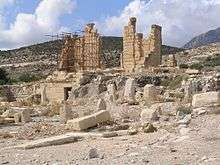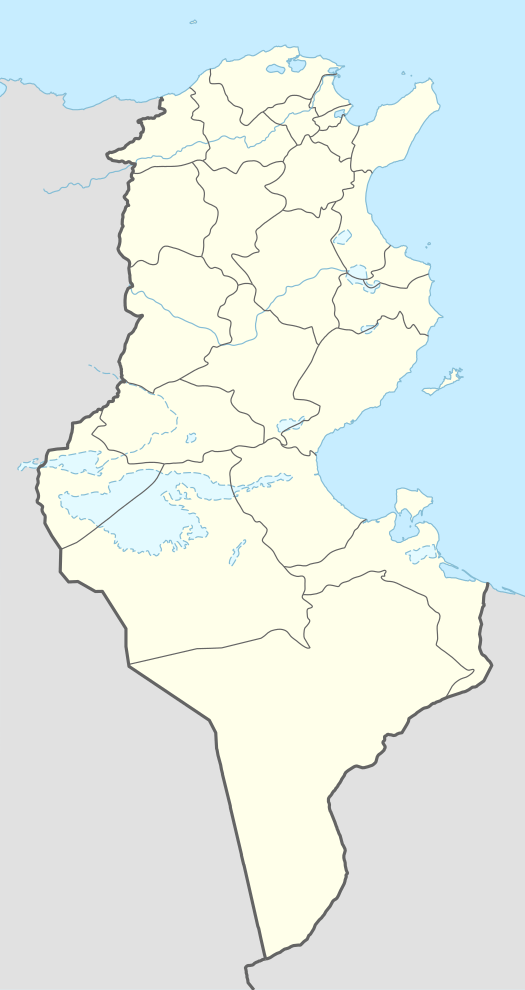Abthugni
Abthugni (Punic: 𐤀𐤐𐤁𐤂𐤍, ʾPBGN, or 𐤀𐤐𐤕𐤁𐤂𐤍, ʾPTBGN)[1] was an ancient city in Roman North Africa[2] at present day Suwar (Henchir-es-Souar) in Tunisia.[3] It was in Roman times in the province of Africa Proconsularis, Africa, and latter in Byzacena. In late antiquity Abthugni was also the seat of a bishop, and the diocese is a titular see of the Roman Catholic Church to this day.
 The ruins at Abthugni | |
 Shown within Tunisia | |
| Coordinates | 36°12′00″N 10°01′00″E |
|---|---|
| Type | Settlement |
Location
The city was located at Henchir-es-Souar in the hill country south of Uthica, 25 kilometres (16 mi) from Zaghouan at an elevation of 200 feet (61 m) above sea level. It was a suffran of Carthage. According to Ferchiou [4] the name of the place is to be reconstructed as Abtugnos.
History
The city was probably founded in the 3rd century BC, and was well established by 30 BC.
Numerous inscriptions have been found documenting the history of Abthugni [5][6][7]
The Roman consul Gaius Rutilius Gallicus performed survey work near Abthugni during the reign of Vespasian.[8] Hadrian made Abthugni a city of Municipium status.[9]
During the Diocletian Persecution the city's Christian community is said to have meet near a cemetery outside the city area,[10] to avoid the jurisdiction of the town officials. In the 4th century during the time of the emperor Valens some of the public buildings were restored.[11]
The town was a Byzantine fortress in late antiquity.[12]
Archaeology
There are a few ruins of the city, including several temples, baths and tombs. The first investigations at the Capitolium of Abthugnos were undertaken by Gauckler and Cagnat at the end of the 19th century. Ernest Babelon lists many preserved buildings, including two temples, the Byzantine city wall, a rectangular basin, and a mausoleum.[13] Recent work was led by Nadié Ferchiou, in the course of which the entire Forum area and the Capitolium were excavated.
Considerable ruins in the Byzantine enclosure include two temples, including a capitol and a rectangular pool which is accessed by thirteen steps. There is also a mausoleum and great many ruined monuments.[14][15][16]
Bishopric
The city was the seat of an ancient bishopric. Known bishops include *Felix of Aptunga, one of three bishops who consecrated Cæcilianus, therefore precipitating the Donatist controversy.[17][18] The proto-Donatist in Cirta called his consecration invalid,[19][20]
- Magnus fl. 345-348
- Felix fl. 411
- Saturnus fl. 525
The diocese ceased to function effectively in the late 7th century with the coming of Islamic armies. However the diocese was re-founded in name in 1933.[21]
The current Bishop is Adelio Pasqualotto[22] who replaced Paul Henry Walshin December 2014.[23]
References
Citations
- Huss (1985), p. 559.
- C. Lepelley, Les cités de l'Afrique romaine au Bas-Empire, 2, 1981, 265–277.
- Marcel Le Glay : Abthugni In:. The Kleine Pauly (KIP). Volume 1, Stuttgart, 1964, vol.
- Ferchiou 1993–95, pp197-202.
- L'Année épigraphique (1991) 1641–1644, 1655.
- Corpus Inscriptionum Latinarum 8, 928–935, 11210, 23084-23094
- Inscriptions latines d'Afrique (Tripolitaine, Tunisie, Maroc). Paris, 1923, pp72-76.
- Corpus Inscriptionum Latinarum 8, 23084.
- Corpus Inscriptionum Latinarum 8, 23085.
- Burns, J. Patout; Jensen, Robin M. (2014). Christianity in Roman Africa: The Development of Its Practices and Beliefs'. Wm. B. Eerdmans Publishing. p. 40.
- L'Année épigraphique(1995), 1655.
- 8007161: Abthugnos (Abthugni) .
- Babelon, Ernest (1893). Archaeological Atlas of Tunisia:. Special edition of the topographical maps published by the Ministry of War Accompanied by an explanatory text. E. Leroux.
- Roman hydraulic installations in Tunisia, III, p.172.
- Carte de l'Atlas archéolgique de la Tunisie: Feuille 42 , footnote 52.
- See also Barrington Atlas, 2000, pl. 32 E4
- Louis Bertrand, Saint Augustin: Top Biography Collections (The Valley Club, 2015).
- Louis Bertrand, Saint Augustin: Top Biography Collections (The Valley Club, 2015).
- Serge Lancel, Saint Augustine (Hymns Ancient and Modern Ltd, 2002)[v p166].
- Bonner Gerald, God's Decree and Man's Destiny: Studies in the Thought of Augustine of Hippo. Church History Volume 57, Issue 4 December 1988, pp. 524–525.
- Titular Episcopal See of Abthugni
- Le Petit Episcopologe, Issue 222, Number 18,381
- Abthugni at catholic-hierarchy.org.
Bibliography
- Huss, Werner (1985), Geschichte der Karthager, Munich: C.H. Beck. (in German)